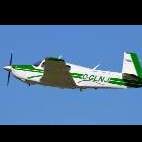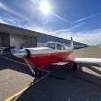-
Posts
268 -
Joined
-
Last visited
-
Days Won
3
Flash last won the day on December 12 2024
Flash had the most liked content!
Profile Information
-
Location
KSMO (Santa Monica, Calif.)
-
Reg #
N315L
-
Model
M20J
Recent Profile Visitors
5,772 profile views
Flash's Achievements
-
Flash started following upgrading - older/newer, slower/faster, value of avionics? , Recommendations for a GA airport in Denver , One more landing or not and 6 others
-
I flew into APA a month ago. Didn't use any services, as I was just handing off a passenger for the next leg of an AngelFlight, so I can't provide any feedback on FBOs. I can say it was busy, which meant a wait for takeoff. OTOH, landing was straight-in without a delay. Controllers were good.
-
You can always go out the baggage door. The only problem is getting the baggage door to lock again once you've gone out through it. On my plane, that has involved partially removing the inside cover to reach in and reset the lock mechanism. This involves removing about 10 small screws and then reinserting them when you're finished.
-
Turns out the injector for the No. 1 cylinder had a contaminant intermittently blocking the fuel flow. Thanks, all, for the input.
-
I have owned my J model for 26 years without a hangar. It has been tied down in Mississippi, Georgia, DC, Connecticut, and California. It has also been tied down when flown to all 49 non-Hawaiian states and numerous countries. It has had a cover in all of those places. There have been days when I wished the plane had spent the night in a hangar so that I didn't have to preheat it or brush the snow off of the wings and elevator or get hot or sunburned while changing the oil. There have been years when I have been glad about all of the money I saved from not paying hangar rent. If a hangar will make you happy, by all means get one. My plane flies. Your plane will fly. Your hangar won't fly. The flying is the fun part.
-
Thanks. There is no EGT2 in this graph. I think the line you thought was EGT2 is MAP.
-
I have an M20J with an IO-360-A3B6 that has about 1300 hours SMOH. Plane was flying great. Took it to a nearby airport to get propeller balanced. When the shop was done (and closed), I fueled and added oil. Had a normal run-up. In the takeoff roll, added full throttle and got much less than full power, plus lots of vibration. Did some additional run-ups and a high-speed taxi and did not get improved results. Re-sumped fuel after shutdown to confirm that wasn't an issue. Engine monitor graph is the second one below. Note how No. 1 cylinder EGT plummeted when I went full throttle and how No. 1 CHT sank, as well. Shop took a look at engine the next day. Borescoped No. 1 cylinder. Everything looked good other than a loose fuel injector connection on the No. 1 cylinder. Did a careful runup. Flew the plane a couple of hours. Flew it a couple of hours the next day. Seemed slightly rougher than usual, but thought I might be imagining things. Also, EGTs peaked at 1 gph higher fuel flow than usual. Flew it again two days later. Definitely rougher than usual, enough so that I decided to turn back to my home base rather than risk having AOG somewhere else. Downloaded the data and saw that the No. 3 cylinder had acted strange and then the No. 1 cylinder had cut out again. Engine monitor graph is the first one below. Today, mechanic found a bit of fuel had leaked from the No. 3 cylinder but found no cracks and no current issue. He cleaned the lower spark plug on No. 3. He borescoped No. 1 but also saw nothing wrong with it. Compressions seemed good. Checked the spider and saw nothing wrong. Checked the No. 1 EGT probe, and it appeared to be working correctly. I went to the run-up area after he'd checked out the plane, to see what would happen. No. 1 cylinder cut out at 1400 RPM. Any diagnostic thoughts here?
-
Relocated my M20J from SQL to SMO a month ago. I'm very happy with the mechanic I used at SQL but am sure to have issues where a trip back to the Bay Area isn't really an option. I see that Bill's moved from SMO. I'd be interested in A&P recommendations from other Mooney owners at SMO and nearby. Please feel free to post here or send me a private message. Thanks in advance.
-
The opinion in Loper Bright Enterprises v. Raimondo is unlikely to have much application to the FAA regulations that apply to us in flying and maintaining our Mooneys. The holding in Loper Bright is that judges should be the arbiters of what a statute means and that a judge need not defer to regulations that purport to interpret a statute even if the statute appears to be ambiguous (although if the statute gives a specific grant of regulatory authority and that grant is constitutional, Loper Bright says that the proper interpretation of that statute is to enforce the resulting regulation). I'm a tax lawyer, not an aviation lawyer, and I can name a lot of regulations promulgated under the Internal Revenue Code that may be subject to challenge under Loper Bright. One reason for that is that there are a lot of statutes in the Internal Revenue Code, so there is a lot of statutory language for judges to interpret. Contrast that with Part 91. The authority the FAA cites for promulgating Part 91 is far more general than the Internal Revenue Code. It's just a handful of statutes: 49 U.S.C. 106(f), 40101, 40103, 40105, 40113, 40120, 44101, 44111, 44701, 44704, 44709, 44711, 44712, 44715, 44716, 44717, 44722, 46306, 46315, 46316, 46504, 46506-46507, 47122, 47508, 47528-47531, 47534; Pub. L. 114-190, 130 Stat. 615 (49 U.S.C. 44703 note); Sec. 828 of Pub. L. 118-63, 138 Stat. 1330 (49 U.S.C. 44703 note); articles 12 and 29 of the Convention on International Civil Aviation (61 Stat. 1180), (126 Stat. 11). The statutes tend to contain broad regulatory grants of authority. For example, section 40103(b)(2) provides: "The Administrator shall prescribe air traffic regulations on the flight of aircraft (including regulations on safe altitudes) for— (A) navigating, protecting, and identifying aircraft; (B) protecting individuals and property on the ground; (C) using the navigable airspace efficiently; and (D) collision between aircraft, between aircraft and land or water vehicles, and between aircraft and airborne objects." If you run afoul of the regulations that apply to buzzing your neighbor's house, you're not likely to have much success pointing to Loper Bright and saying that the regulations are not "law" because they are not the best interpretation of this statutory language. I'm not saying that there can be no challenges to FAA regulations under Loper Bright. Congress did set out specific statutory rules regarding ELTs, and enforcement via civil and criminal penalties, and a short list of other topics. But I would be very surprised if Loper Bright could be wielded to challenge most of the regs that apply to us.
-
If your money was on the master relay, you are a winner. It has been replaced.
-
No. 2 GI-275 has an internal battery that provides at least an hour of attitude indicator if the No. 1 fails. Thus, having it come on as an AI shows that it is working as it should but does not suggest that any power is flowing from the main battery.
-
Symptoms: Last few times I tried to start my M20J, I turned on the master switch and either (1) my No. 2 GI-275 came on as an attitude indicator, with no power to the No. 1 GI-275 or the engine monitor, meaning I wasn't getting electrical power from the battery to the panel (the No. 2 GI-275 has a backup battery that, apparently, is working as designed!), or (2) everything worked normally. When it worked, the plane started and ran fine. Is this probably the master switch itself (try a little contact cleaner and hope this solves things) or the master relay? Any easy way to diagnose?
-
Don, using FlyQ+ on my iPhone, I can click on the map near the airport, which calls up a screen showing the airspace, the airport, and a nearby LOM. I then click on my airport's name (not on the Direct, +FP, charts, or map icons underneath it), and that takes me to a screen for the airport. That screen allows me to choose Gen, Wx, Proc, A/FD, Notm, Svc, or Near. If I choose A/FD, it shows me an image of the appropriate pages in the A/FD for the airport. If you're trying to get to another section of the A/FD, though, I haven't figured that one out yet.
-

upgrading - older/newer, slower/faster, value of avionics?
Flash replied to AJ88V's topic in General Mooney Talk
I resisted any avionics upgrade (other than an ADSB-compliant transponder) for my first 22 1/2 years of ownership and was perfectly happy. But I realized I'd get added performance from a WAAS GPS and decided if I was going to do that I should do some other things at the same time. I really love my IFD 540 and my dual GI-275s. I flew a DME arc on a recent IPC and felt like I was cheating it was so easy, even after I disengaged the autopilot with GPSS. The ability to fly LPV approaches was a real benefit to my upgrade, but it's not so much that I'm able to do more with my plane than I was before, and more about being able to do the same things more easily. Considering my missions can involve long days of flying, I'm probably getting a safety benefit because the flying is less demanding than it used to be. Like you, I thought about buying a faster plane instead of doing an avionics upgrade. I decided I don't need that; my plane gets me where I'm going plenty fast enough. YMMV. Choose additional speed/altitude/engines if that's what floats your boat. If you don't make that choice, an avionics upgrade will definitely make a difference in your flying experience. -
En route MMQT-MMOX, I got a couple of shots of Mount Popocatepetl, which is southeast of Mexico City. There was a sigmet for volcanic ash downwind of this; I flew on the upwind side.
-
- 13
-







